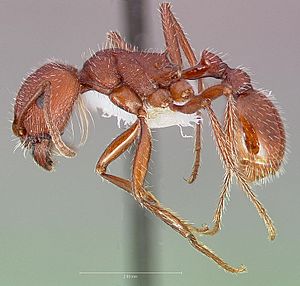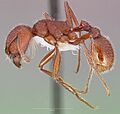Western harvester ant facts for kids
Quick facts for kids Western harvester ant |
|
|---|---|
 |
|
| P. occidentalis worker from California | |
| Scientific classification | |
| Kingdom: | |
| Phylum: | |
| Class: | |
| Order: | |
| Family: | |
| Subfamily: |
Myrmicinae
|
| Tribe: |
Myrmicini
|
| Genus: |
Pogonomyrmex
|
| Species: |
P. occidentalis
|
| Binomial name | |
| Pogonomyrmex occidentalis (Cresson, 1865)
|
|
The western harvester ant (Pogonomyrmex occidentalis) is a type of ant. It lives in the dry deserts and grasslands of the American West. You can find them at elevations up to about 6,300 feet (1,920 meters).
These ants are called "harvester ants" because they collect seeds and other food. Their scientific name, "occidentalis", means "of the west". This shows they are common in the western USA. Their nests are easy to spot. They build mounds of gravel surrounded by bare ground. If there are too many of these ants, they can reduce grazing plants. This can be a problem for the environment and for farmers. Be careful, as they have a painful, venomous sting!
Contents
Ant Colonies
A full-grown ant colony can have up to 20,000 workers. It has only one queen. A queen ant can live for up to 40 years. Many colonies survive for 20 years.
These ants build deep nests, sometimes up to 16 feet (5 meters) deep. The queen stays at the bottom of the nest. Worker ants move around the nest. They also move the young ants (brood) to warm, safe spots.
The top of a colony's nest is a cone-shaped mound. This mound can be over 35 inches (89 cm) wide. The mound's look and size change depending on the plants nearby. Most mounds have a clear area around them without plants. This helps protect the nest from fires. Bigger colonies usually have bigger mounds.
New colonies are started by a single queen. She does this all by herself. Many young colonies do not survive their first year. Worker ants sometimes kill queens they find outside the nest. The first workers born are very small. They are about 2 mm long. This is much shorter than regular workers.
Worker Ants
Worker ants are usually dark red. In a mature colony, they are about 6 mm long. Workers come in different sizes. However, they do not have special groups for different roles. A worker ant lives for about six months. As they get older, they take on different jobs. For example, older workers often go out to find food.
Workers are active when the temperature on the nest mound is between 77°F and 127°F (25°C and 53°C).
What Western Harvester Ants Eat
Worker ants collect seeds and pollen directly from plants. They also gather seeds that have fallen to the ground. Some seeds are stored in special rooms inside the nest. These stored seeds are eaten during winter. Workers also collect insects that have recently died.
These ants usually look for food from April to September. They forage all day during cooler months. In summer, they forage from 5 to 11 AM and from 3 to 9 PM. Colonies with more genetic variety forage for more hours each day.
When given a choice, workers pick seeds with more energy. They also choose a variety of seeds or new types of seeds. Workers usually focus on one type of food each day. But they can change their specialty daily. They often forage in the same direction over and over.
Colonies send more workers to good food sources. They also defend their foraging areas from other colonies. Different plant areas can support different numbers of colonies.
Living with Myrmecocystus mexicanus
Scientists have studied how western harvester ants live near another ant species. This other ant is called Myrmecocystus mexicanus, or the North American honey ant. They found that these two ant species often live close to each other.
Scientists also saw that M. mexicanus eats western harvester ants that are dead or dying. They believe that western harvester ants are a main food source for the honey ants. This is why honey ants build their nests near western harvester ant colonies. There is no strong proof that honey ants actively hunt healthy western harvester ants.
Ant Growth and Development
Different stages of ants in a colony eat different foods. Young ants (larvae) eat solid food. Adult ants drink liquids, including liquids from the larvae. Young ants need help from adults to grow. Adults help them shed their old skins as they grow. Larvae cannot move much. So, adults bring food to them or move the larvae to the food.
Colonies stop producing new young ants before winter.
Reproduction and New Colonies
Ant colonies release special winged ants called alates. These alates fly out at the same time. They meet and mate in large swarms on hilltops. These mating swarms can be about 0.9 miles (1.4 km) apart. Queens can fly up to 0.5 miles (800 meters).
Female queens usually mate with several different males. Queens that mate with more males tend to have faster-growing colonies. After mating, queens find bare, bright spots to land. Then, they dig into the ground to start a new nest.
New colonies often start in groups around these mating sites. Over time, the colonies spread out more evenly. Colonies that are further from older colonies have a better chance of surviving. Smaller nests are more likely to die. The further a small colony is from its closest neighbor, the higher its chance of survival. The age and size of a colony are connected, especially for young colonies.
Images for kids


